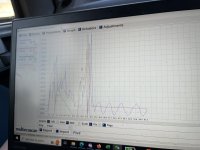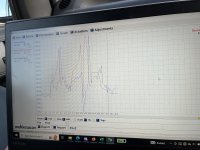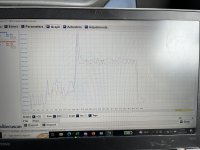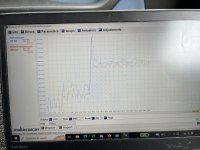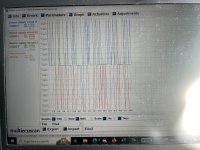So from those reading does that mean Dave could put a 3.81 Kohm resister across UFI plug to indicate a 10 degree Centigrade reading and if the UFI sensor is faulty the resistor would give a median reading for test purposes?
You are using an out of date browser. It may not display this or other websites correctly.
You should upgrade or use an alternative browser.
You should upgrade or use an alternative browser.
Technical Multijet no start.
- Thread starter DaveMcT
- Start date
Currently reading:
Technical Multijet no start.
YesSo from those reading does that mean Dave could put a 3.81 Kohm resister across UFI plug to indicate a 10 degree Centigrade reading and if the UFI sensor is faulty the resistor would give a median reading for test purposes?
- Joined
- Sep 14, 2009
- Messages
- 19,828
- Points
- 3,385
I tried AlfaOBD but it won’t work unless paid for. Now removed from computer. AlfaDiag appeared in various places which looked dodgy so did not download.
MES is now working fine. Who knows why it refused to show live values.
New fuel filter seems to have removed the high fuel temperature errors and I have connectors that font have broken release caps. However I am getting a spike drop in fuel pressure that throws up the warning light and it’s getting worse. It spikes down and straight back up.
It seems to be be consistent with pressing the throttle pedal. But I’m not sure of that because it doesn’t happen at idle.
Fuel pressure has reached 550 bar at 2000rpm. The pressure drop is so steep, I think it’s being commanded by a valve or signal to a valve.
Any ideas what can cause the fuel rail pressure to drop to zero and jump straight back? faulty valve? Faulty pressure sensor?
MES is now working fine. Who knows why it refused to show live values.
New fuel filter seems to have removed the high fuel temperature errors and I have connectors that font have broken release caps. However I am getting a spike drop in fuel pressure that throws up the warning light and it’s getting worse. It spikes down and straight back up.
It seems to be be consistent with pressing the throttle pedal. But I’m not sure of that because it doesn’t happen at idle.
Fuel pressure has reached 550 bar at 2000rpm. The pressure drop is so steep, I think it’s being commanded by a valve or signal to a valve.
Any ideas what can cause the fuel rail pressure to drop to zero and jump straight back? faulty valve? Faulty pressure sensor?
Attachments
That vertical drop recorded on your MES seems similar to what my MaxiECU showed when we tested, no gradual decline.I tried AlfaOBD but it won’t work unless paid for. Now removed from computer. AlfaDiag appeared in various places which looked dodgy so did not download.
MES is now working fine. Who knows why it refused to show live values.
New fuel filter seems to have removed the high fuel temperature errors and I have connectors that font have broken release caps. However I am getting a spike drop in fuel pressure that throws up the warning light and it’s getting worse. It spikes down and straight back up.
It seems to be be consistent with pressing the throttle pedal. But I’m not sure of that because it doesn’t happen at idle.
Fuel pressure has reached 550 bar at 2000rpm. The pressure drop is so steep, I think it’s being commanded by a valve or signal to a valve.
Any ideas what can cause the fuel rail pressure to drop to zero and jump straight back? faulty valve? Faulty pressure sensor?
Can you get any voltage readings at the fuel pressure regulator to maybe indicate an electrical fault, if it isn't a mechanical issue at the regulator.
- Joined
- Sep 14, 2009
- Messages
- 19,828
- Points
- 3,385
The fault is getting more frequent but it’s still the same transient spike down and up again.
Mrs Dave has the computer so I can’t see if it lists a fuel pressure relief valve signal. But I’ve been looking closely for things to graph and not seen anything.
It’s probably possible to spoof the common rail pressure sensor with a resistor. That might rule it out as a trouble maker.
By the way when it did work, the engine felt really good. Much smoother at low revs.
Mrs Dave has the computer so I can’t see if it lists a fuel pressure relief valve signal. But I’ve been looking closely for things to graph and not seen anything.
It’s probably possible to spoof the common rail pressure sensor with a resistor. That might rule it out as a trouble maker.
By the way when it did work, the engine felt really good. Much smoother at low revs.
We are jumping all over the place
Start at the begining
Disconnect the electrical connectors from the injectors
Measure the RPM and fuel pressure
Post the results
Depending on the results we can either move on or fix
Until then we can't even start to interrupt the figures or start to move forwards
Start at the begining
Disconnect the electrical connectors from the injectors
Measure the RPM and fuel pressure
Post the results
Depending on the results we can either move on or fix
Until then we can't even start to interrupt the figures or start to move forwards
What is the duty cycle of the pressure relief valve at idle
- Joined
- Sep 14, 2009
- Messages
- 19,828
- Points
- 3,385
I cannot find a fuel pressure relief valve on the ECU listing.
I did find the engine ECU earth was not connected. It is now and there’s no difference at all.
It idles fine and revs no problem, but a normal acceleration throttle pedal under load causes the spike pressure drop. It works normally thereafter though with reduced power.
Can the Crank Sensor cause transient faults? It’s unlikely as I’m becoming sure it happens when I load the engine.
Latest trace
The sensors are not labelled so I’ve no idea what each does.
I did find the engine ECU earth was not connected. It is now and there’s no difference at all.
It idles fine and revs no problem, but a normal acceleration throttle pedal under load causes the spike pressure drop. It works normally thereafter though with reduced power.
Can the Crank Sensor cause transient faults? It’s unlikely as I’m becoming sure it happens when I load the engine.
Latest trace
The sensors are not labelled so I’ve no idea what each does.
Attachments
- Joined
- Sep 14, 2009
- Messages
- 19,828
- Points
- 3,385
Fuel pressure is around 300 bar at idle. It’s goes to around 550 at 2000 rpm. The transient fault happens when I try to accelerate.
What will disconnecting the injectors signal wires tell us?
What will disconnecting the injectors signal wires tell us?
The fuel pressure regulator on yours is at the opposite end of the common rail to the pressure sensor. Where all the return/leakoff pipes are.
- Joined
- Sep 14, 2009
- Messages
- 19,828
- Points
- 3,385
It’s presumably commanded to open/close by the Pressure Sensor at opposite did of the fuel rail. Isn’t that more likely to be the issue?
Fuel pressure looks good and the pressure drop is sudden. Makes me suspect the sensor but how can we prove it’s working correctly?
Fuel pressure looks good and the pressure drop is sudden. Makes me suspect the sensor but how can we prove it’s working correctly?
Been reading this with much interest but no real insights, until I remembered that the boost actuator fiddles with fuel pressure when it detects an overboost condition... any chance it is causing the fuel pressure drop? Possibly loose connection or faulty sensor. It doesn't sound like the "classic" stuck actuator, but the result sounds vaguely familiar.
At the moment we are guess and making assumptions at to what we are seeingFuel pressure is around 300 bar at idle. It’s goes to around 550 at 2000 rpm. The transient fault happens when I try to accelerate.
What will disconnecting the injectors signal wires tell us?
We have to start somewhere
We know what the fuel pressure at 200 RPM without the injectors firing should be, fiat published the data
Why not start there
- Joined
- Sep 14, 2009
- Messages
- 19,828
- Points
- 3,385
With injectors unplugged the ECU sends no data that can be seen. Engine speed and injection pressure parameters remain empty.
I recorded engine start (glow plugs u/s) as shown. Engine fired up at around 250 bar and similar rpm. I don’t know if the rate of pressure rise during cranking is normal. It is similar to what this engine did when warm. Here it’s at summer ambient.
I took it for a drive with MES recording and got the fuel cut off the moment I properly pressed the accelerator. Fuel trace did the same jab down as I pressed the accelerator.
After that, I can work the accelerator any way I like. Power is reduced ( I guess It’s in limp mode) but the pressure trace stays up. There are no more lurches as fuel momentarily cuts off.
I recorded engine start (glow plugs u/s) as shown. Engine fired up at around 250 bar and similar rpm. I don’t know if the rate of pressure rise during cranking is normal. It is similar to what this engine did when warm. Here it’s at summer ambient.
I took it for a drive with MES recording and got the fuel cut off the moment I properly pressed the accelerator. Fuel trace did the same jab down as I pressed the accelerator.
After that, I can work the accelerator any way I like. Power is reduced ( I guess It’s in limp mode) but the pressure trace stays up. There are no more lurches as fuel momentarily cuts off.
Last edited:
I note the 6 Bar reading is not far from the 7 Bar my MaxiEcu recorded at same point when we tested it the other week.With injectors unplugged the ECU sends no data that can be seen. Engine speed and injection pressure parameters remain empty.
I recorded engine start (glow plugs u/s) as shown. Engine fired up at around 250 bar and similar rpm. I don’t know if the rate of pressure rise during cranking is normal. It is similar to what this engine has always done.
I took it for a drive with MES recording and got the fuel cut off the moment I properly pressed the accelerator. Fuel trace did the same jab down as I pressed the accelerator.
Once it has done that and raised the ELM, I can work the accelerator any way I like. Power is reduced ( I guess It’s in limp mode) but the pressure trace stays up. There are no more lurches as fuel momentarily cuts off.
View attachment 448648
In the absence of any electrical readings it could still be a mechanical fault at the pressure regulator like I suggested before.
Does yours look like this? As I think the other version is on the high pressure pump and I know yours doesn't have anything electrical on the pump. I am not suggesting going out and buying it on spec. but it may be worth ultrasonically cleaning it and testing electrically if any one has the data.
- Joined
- Sep 14, 2009
- Messages
- 19,828
- Points
- 3,385
Mine looks like this. I found a seal kit on eBay. Probably worth getting as seals are likely to fail when it’s opened for cleaning.
I’ve also found an old video for testing the sensor. It’s contemporary with the car so should be relevant.
I’ve also found an old video for testing the sensor. It’s contemporary with the car so should be relevant.
Last edited:
- Joined
- Sep 14, 2009
- Messages
- 19,828
- Points
- 3,385
This Is a simple test for the pressure control valve. He removes and clamps the return to tank. Does the same on injector leak offs. Puts a collection pot on a short hose and cranks the engine. Any fuel coming down is a failed control valve.
That’s an easy functional test.
That’s an easy functional test.
- Joined
- Sep 14, 2009
- Messages
- 19,828
- Points
- 3,385
This also helps narrow it down
Are you sure your video shows otherwiseI recorded engine start (glow plugs u/s) as shown. Engine fired up at around 250 bar and similar rpm. I don’t know if the rate of pressure rise during cranking is normal. It is similar to what this engine did when warm. Here it’s at summer ambient.
Looks to me like it fired at below 156 bar ?
Get some diagnostic software that works
Whilst I would agree with @koalar that ideally diesel injection starting pressure should be around 300 Bar, I regularly see starting pressures of 230Bar with no issue starting.
I was surprised to read this though , which may indicate an even lower pressure will permit starting, although obviously not ideal.:-
"Diesel fuel injectors require a set pressure of a minimum of 150 bars in order to start injecting fuel into the combustion chamber."
Injector Removal Services
"You should be seeing fuel pressure over 150 bar for a car to start. Lower than that you can't expect it to start.

TDIClub Forums
I was surprised to read this though , which may indicate an even lower pressure will permit starting, although obviously not ideal.:-
"Diesel fuel injectors require a set pressure of a minimum of 150 bars in order to start injecting fuel into the combustion chamber."
Fault Fixing for Diesel Engine Non-Start
Injector Removal Services
"You should be seeing fuel pressure over 150 bar for a car to start. Lower than that you can't expect it to start.
Pump or Rail Pressure while cranking? - TDIClub Forums
TDIClub Forums


